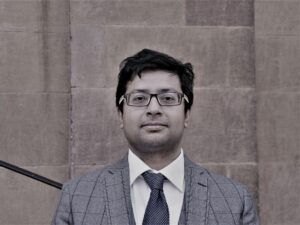Dr Vikram Pakrashi
Assoc Prof of Mechanical Engineering at UCD
Let’s meet Dr Vikram Pakrashi, Associate Professor of Mechanical Engineering at UCD and lead of the NexSys Offshore Wind strand. Vikram is a Chartered Engineer and Fellow of Engineers Ireland. He is the current EU president of Eurostruct, The European Association on Quality Control of Bridges and Structures. He also leads the UCD Centre for Mechanics, represents Ireland in the International Union of Theoretical and Applied Mechanics, sits in the Engineering and Computer Science Committee of Royal Irish Academy and serves as Director of the UCD Dynamical Systems and Risk Laboratory (DSRL). Vikram sits in the Scientific Working Group on decarbonisation of transport infrastructure construction under DG-MOVE.

What is your research about?
On a fundamental level, my research is concerned with systems that change over time: this is called dynamics. My research brings together three elements: fundamental mechanics; sensors and monitoring; and robust data analytics.
My core topic of work around mechanics is a very classical field with a long history, and it comes with a range of applications. One of the main ones is de-risking of infrastructure. Examples range from wind turbines, to bridges, pipelines to gearboxes. This type of infrastructure is often referred to as ‘critical assets’ and can make infrastructure ‘lifelines’.
I spent several years working in the built infrastructure sector in Ireland, and this experience has afforded me an industry-oriented approach when it comes to research.
Can you explain what you mean by risk?
Risk can be thought of as the chance of something happening multiplied with the consequences of it happening. In my research, we’re talking about reducing risks and also increasing commercial viability throughout the lifetime of structures such as wind turbines.
Can you talk us through an example of de-risking?
Let’s take the example of an offshore wind turbine. You would start right from the concept stage, moving on to the design and testing stages going through the technological readiness levels, the construction stage, and then the decommissioning stage, all the while considering different needs and unknowns throughout the life cycle of the turbine. We are also considering here the alignment to and creation of new guidelines and recommendations throughout its life cycle. It’s not just about making things safer, it’s about making things safer, stronger, longer lasting and more sustainable.
At the beginning [concept stage], people often use their disciplinary strengths to come up with great ideas, but many of them don’t end up being progressed due technical, financial, legal, economic, and social considerations. The devil lies in the details. There is a risk that you choose the wrong set of solutions and spend a lot of money and time on them, only to realise much later that they don’t deliver at the level where you want them to. So it is important to test the solutions early, at increased scales and considering multiple perspectives.
If we look at examples of risks, there are risks associated with construction, performance of the lifetime exposed to high and multiple hazards (wind, wave, soil conditions, consider even earthquakes in some countries), connection of cables, impacts on the environment, public perception, coastal erosion, impacts on existing coastal infrastructure, access to the turbine for inspection or monitoring in inclement weather, health and safety of people who work in these environments, and operational and capital expenditures. There are many more. Not everyone has to know about everything, but these risks do combine and come together impacting the final solution. We need guidelines on every level, and we need specialist talent at each of the stages.
Once you have decommissioned a turbine, which comes with associated risks, there’s another risk to consider: what to do with them? A lot of turbines are coming to the end of their life (about 30 years) and think about how many blades which might just end up in landfill or similar situations. I’m involved in a project led by Munster Technological University and University College Cork (Kieran Ruane, Vesna Jaksic, Paul Leahy are who I work closest with here), which is investigating what to do with second-hand equipment such as blades. As part of this work, a pedestrian bridge called Blade Bridge (~5m span) made out of ~11m-long used wind turbine blades was built in Cork in 2022. I am also looking at analysis and monitoring of ropes and cables as part of my NexSys research – these can often be wicked hard problems.
After decommissioning and recycling, there’s another risk to think about. Think of energy like crops. Imagine you have harvested crops on a piece of land. Would you replant your new crops on the same land or do you need different land? The repowering of wind turbines is a big question, especially considering the stress signature and geotechnical fatigue of the site.
How do you see the process of translating research into practice and application in industry? Is that something that applies to your research in NexSys and the UCD Centre for Mechanics?
A lot of my work starts from tech-readiness zero, which is absolutely from fundamentals. For instance, in the UCD Centre for Mechanics, we look at fundamentals, as far away as possible from application. When something interesting comes out of this work, then we move it forward towards application, in a synergistic way. Within NexSys, we do industry-facing research, linking fundamentals with actual needs and practice, which is very important.
The first step in this process is to establish credentials, including benchmarks, repeatability, and transparency in terms of results. But your work must also adapt to guidelines, recommendations, and standardisation processes. Any standardisation process can take a very long time, so it is best to create as many pipelines towards standardisation as possible. This is a big focus of my work. When these elements come together, it is industry-facing research. And of course, throughout this process, we are respecting rigour and guided by fundamentals.
When thinking of industry-facing research, there is a strong need to create an environment of openness and trust between all stakeholders, from academia, to industry, to the general public. This means having very transparent guidelines and evidence in place, and sharing data and information. Once you create public good research with clear outcomes, and once you share information, data and methods, you remove a lot of smokescreens from industry and academia, and what’s good practice becomes obvious.
Can you tell us more about your work with sensors and modelling?
Monitoring is another important aspect of my research. We do this through sensors, electronics, data science, communication and edge devices. Lots of sensors are needed. For example, when it comes to individual turbines, they can be fitted with accelerometers and strain gauges obtaining global vibration characteristics and local responses, respectively. These are indicative of their structural health and how they evolve over time – linking back to risk and lifetime operations and maintenance. There are also many other sensors like anemometers, measuring wind speed and directions and many other modern instruments using the various responses of the structure to understand more about it in its operational condition and sense what it needs when. Sensors can be used for estimating remaining capacity, fatigue and be combined with several other tests linked tom materials testing and modern inspections which often include image processing (e.g. underwater images for various light and turbidity) and the use of non-contact devices (e.g. Doppler Vibrometry) underwater imaging. This also means that we are dealing with complex and messy data from many channels and we continue to create bespoke and robust artificial intelligence and machine learning solutions for these.
Within NexSys, you lead the Offshore Wind strand. What are the aims of this research strand?
In the NexSys Offshore Wind strand, we tackle some of the key challenges in the offshore wind sector an interdisciplinary manner and in close collaboration with industrial partners, leading to safer lifetime performance, improved operations & maintenance and cutting-edge innovations by assimilating fundamental physics, advanced experimentation, sensor networks, high-end computing and data analytics/AI.
You are a member of the UCD Just Transition research group. Can you tell us about the importance of the Just Transition in your view?
As engineers, we have the skills to do something to solve a problem, but sometimes there is a lack of understanding about exactly why we are doing this, who it will benefit, and who it will affect – these questions should be more robustly debated. When it comes to the just transition, engineers don’t speak the language, so to get the vocabulary right, this understanding right, that is the first step. Let it not be the Tower of Babel! This is why engaging with just transition and related research is very important.
What is your view of interdisciplinary research?
Interdisciplinary excellence couldn’t be more timely and relevant for offshore wind in Ireland, and in the world. This is a rapidly evolving sector which is fundamental to Ireland’s aspirations around clean, consistent and competitive energy supply. There is a tangible need for academic excellence to go hand in hand with industrial relevance.
The nature of the problems we face mean we cannot afford not to be interdisciplinary. Disciplinary boundaries are pretty much dissolved.
When it comes to working in a research group, what is your vision of the culture that you wish to instil and encourage in your team?
My aim is to lead a happy and inquisitive team. When I say happiness, I mean working in a content way, with dignity and a certain flow. People should not be fearful of questioning, or asking/receiving questions in a very honest and direct manner. That’s what I want to foster, without any feeling of fear. You should be able to question the validity of another person’s answer and not feel awkward about it. And you do not have to come across as impolite in the process either. Of course, there are high expectations in terms of rigour and work, but at the same time it is important that there is an environment of support and trust, where ease of communication and an innate trust in the group allows any issue to be addressed early on.
In order to nurture that inquisitiveness in the group, we can ask ourselves: Do you remember when you were young and you used to be overjoyed with something, filled with curiosity? When was the last time you had that feeling?
I encourage people in the research group to tap into that, to have insight into when they feel this joy. And it’s a very messy process, and not the only process to follow. But it’s been working in this group, just trying to follow our passions. But passion without training is nothing, so of course we must add rigorous training to this. Working with colleagues in this way clearly comes with a lot of responsibility. We are talking about human beings devoting prime years of their lives in these projects. You need to be very, very aware of this.
